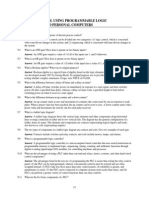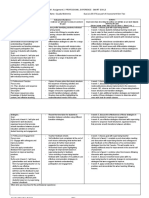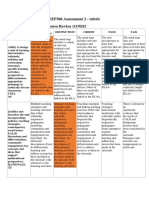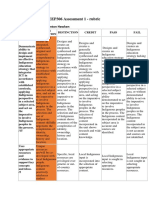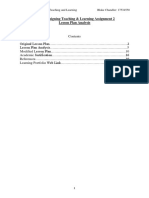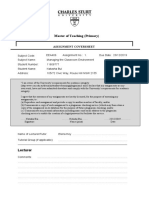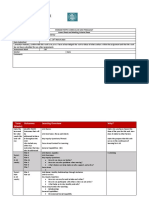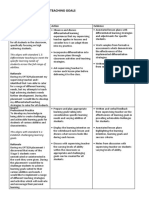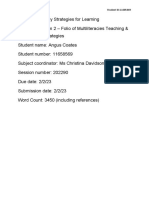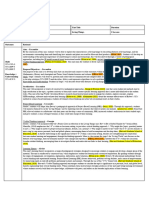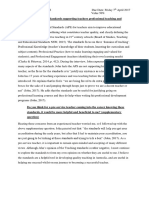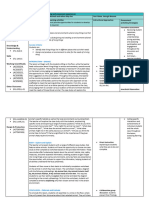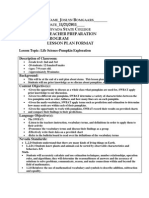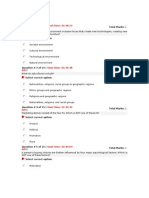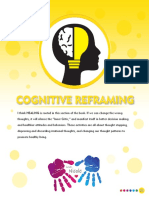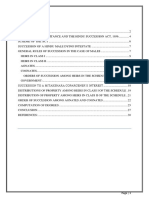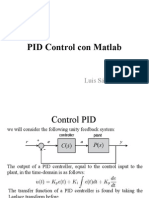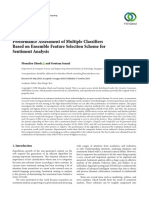0 ratings0% found this document useful (0 votes)
169 viewsEmm209 Lesson Plan Assess1
Emm209 Lesson Plan Assess1
Uploaded by
api-369359038The document provides details of a Year 3 mixed abilities mathematics lesson on multiplication and division. The lesson aims to have students use problem solving skills to multiply and divide by 2 and 4, and apply the inverse relationship between multiplication and division. The lesson introduces a word problem involving pets at a school having a total of 50 legs. Students work in groups to highlight important words and use symbolic and pictorial representations like acting out on a basketball court to discover the combinations of students and pets that could equal 50 legs. Formative assessment is conducted through questioning and evaluating students' representations.
Copyright:
© All Rights Reserved
Available Formats
Download as DOC, PDF, TXT or read online from Scribd
Emm209 Lesson Plan Assess1
Emm209 Lesson Plan Assess1
Uploaded by
api-3693590380 ratings0% found this document useful (0 votes)
169 views3 pagesThe document provides details of a Year 3 mixed abilities mathematics lesson on multiplication and division. The lesson aims to have students use problem solving skills to multiply and divide by 2 and 4, and apply the inverse relationship between multiplication and division. The lesson introduces a word problem involving pets at a school having a total of 50 legs. Students work in groups to highlight important words and use symbolic and pictorial representations like acting out on a basketball court to discover the combinations of students and pets that could equal 50 legs. Formative assessment is conducted through questioning and evaluating students' representations.
Original Title
emm209 lesson plan assess1
Copyright
© © All Rights Reserved
Available Formats
DOC, PDF, TXT or read online from Scribd
Share this document
Did you find this document useful?
Is this content inappropriate?
The document provides details of a Year 3 mixed abilities mathematics lesson on multiplication and division. The lesson aims to have students use problem solving skills to multiply and divide by 2 and 4, and apply the inverse relationship between multiplication and division. The lesson introduces a word problem involving pets at a school having a total of 50 legs. Students work in groups to highlight important words and use symbolic and pictorial representations like acting out on a basketball court to discover the combinations of students and pets that could equal 50 legs. Formative assessment is conducted through questioning and evaluating students' representations.
Copyright:
© All Rights Reserved
Available Formats
Download as DOC, PDF, TXT or read online from Scribd
Download as doc, pdf, or txt
0 ratings0% found this document useful (0 votes)
169 views3 pagesEmm209 Lesson Plan Assess1
Emm209 Lesson Plan Assess1
Uploaded by
api-369359038The document provides details of a Year 3 mixed abilities mathematics lesson on multiplication and division. The lesson aims to have students use problem solving skills to multiply and divide by 2 and 4, and apply the inverse relationship between multiplication and division. The lesson introduces a word problem involving pets at a school having a total of 50 legs. Students work in groups to highlight important words and use symbolic and pictorial representations like acting out on a basketball court to discover the combinations of students and pets that could equal 50 legs. Formative assessment is conducted through questioning and evaluating students' representations.
Copyright:
© All Rights Reserved
Available Formats
Download as DOC, PDF, TXT or read online from Scribd
Download as doc, pdf, or txt
You are on page 1of 3
Unit/Lesson Title Having fun with 2 and 4 Stage: 2 Year:3 mixed abilities class
Aim for the lesson: Syllabus Outcomes:
Students will successfully use problem solving skills and will mulitply by 2 MA2-1WM uses appropriate terminology to describe, and symbols to
and 4 and divide by 2 and 4 by applying the inverse relationship of division represent, mathematical ideas
and multiplication to justify answers. MA2-2WM selects and uses appropriate mental or written strategies, or
technology, to solve problems.
MA2-3WM checks the accuracy of a statement and explains the reasoning
used.
MA2- 6NA- uses mental and informal written strategies for multiplication
and division.
MA2-5NA uses mental and written strategies for addition and subtraction
involving two, three, four and five-digit numbers.
Prior Knowledge Resources.
Students can describe mathematical situations and methods using everyday Interactive white board with problem and graphics for fun
and some mathematical language, actions, materials, diagrams and symbols 26 photocopies of problem, one for each member of the class
and can use a range of mental strategies and concrete materials for 13 assorted highlighters
multiplication and division. 6 sets of pet cutouts and stick men cutouts in plastic zip lock bags 1 green
background per cutouts
Maths grid books and led pencils
Access to school basketball court or hall in advent of bad weather.
Learning Experiences (include details about class-organisation and teaching strategies, where relevant) Assessment
Introduction (Engagement)
EXPERIENCE
6 small groups of 4 to 5 students maximum, teacher selected seating arrangement for hetrogeneous groupings all desks facing IWB.
Teacher led discussion Who has pets at home? Discussion about what kinds of pets if anyone has any unusual pets. What can we then say about
most of our pets? Do they all have four legs? Yes as most students have cats, dogs, rabbits, guinea pigs etc.
Today we are going to be using this knowledge of our pets to help us solve a problem.
Introduction of Problem on IWB with fun graphics of pets.
On bring your pet to school day the students in Mr Whites class take their pets onto the oval. On the
oval there are a total of 50 legs. We do not know how many children or pets there are. Suppose all
pets have 4 legs, investigate the combinations of children and pets there could be.
Hand out of copy of problem for each student and give students some thinking time to read and understand the problem themselves.
Body
(Exploration/Transformation/Presentation)
LANGUAGE
Discuss the language of the problem what are the important words in the problem that will help us solve it? The problem tells us we have pets
(four legged) what can we suggest about the number of legs students have (2 legs)? Why is this important? How many legs are there on the oval in
total? Why is this important?
Now pair up with the person next to you and with your highlighters, highlight the words you think are important that will help you to solve the 1 st
part of this problem. Is it important to know we have 50 legs on the oval in total? Why is knowing there are 50 legs important?
Be prepared for some interesting reasons and if incorrect model the correct answer but praise for having a good try. Formative
We need to know the total number of legs so as we can then start thinking about how many lots of different combinations of pet and student assessment
legs there can be. That is the combinations of 2s and 4s that together make up the number 50. knowledge
SYMBOLIC intergration
Take students out to the basketball class with their copies of their problems. (this exercise is for the Kinaesthetic and Auditory learners in the can be
group) understood by
Suggest that the middle third of the basket ball court is the oval and they are going to be pretending to be pets and students to investigate the the quality of
different ways there can be pets and students on the oval. the answers
OK now first we are going to count by 2s to see how many students legs can be on the oval start with one student and have all students count given to
their number as they enter the court. 2,4,6,8,10 and so on up to 20 students on the court. Now we have 40 legs on the oval so how many more legs questions
can I have on the oval before I have one pet? Remember pets have four legs. Suggest a student now go onto the court on all fours. Ask students now posed.
how many legs in total on the oval? They should be able to repond 44 legs (40 + 4 = 44). So if I need 50 legs in total on the oval and I now have 44
legs because I have 20 students and 1 pet how many legs do I still need on the oval? That is 50 44 = 6 legs? For those not making the connection
suggest 10 6 is 4. Gives me 6 legs to go onto the oval. If I have six legs how many more students do I need? How many lots of 2 make 6? Yes 3!!!
3 more students. So how many student are on the oval? Yes 23 and how do I know that? Because I have 23 x 2 legs and that makes 46 student legs
or the reverse operation of that is? 46 legs divided by 2 = 23.
So this is our first combination 23 students and 1 pet. Or 23 lots of 2 and 1 lot of 4 to make 50.
What happens now if I want to add another pet? Do I have to remove a student? If pets have 4 legs how many students do I have to remove to add 1
pet. Yes? I have to remove 2 students. So now we have 21 students and 2 pets. Have 2 students come off the court and one enter on 4 legs.
So can we see what is happening when we add a pet? Can we predict what will happen to the number of students every time we add a pet? Yes
everytime we add a pet we have to remove 2 students. Why is that? Because 4 is 2 x 2 or double 2.
Teacher praises for excellent work and now directs students back to class room. Class return to seating arranged desks.
PICTORIAL
In class teacher shows pictorial representaton of 2 pets and 21 students and asks students to draw ther own representations of the next 3 Teacher can
combinations using stick men and stick on animals from their plastic bags of resources in their work books. This is encouraging systematic work to formtively
discover all possible combinations (this exercise is for visual learners). Teacher walks around classs room giving help to those who need it. assess for
For those working ahead who can be extended they can go staight to a chart of students and pets as they will be able to ascertain that for each pet I learning given
take away 2 students from my previous total (catering for a diversity of learners) the pictorial
This reafirms the content for visual learners and for learners who value interactions with reading and writing text. representations
Gifted and talented students may now move onto the challenge questions as they have a chart that represents all possible combinations. and charts
They will be able to explain in words why when there are 8 pets there has to be 9 students. They will be able to rationalise that it is because pets being drawn.
have double the amount of legs as people and therefore we have 32 pet legs and 18 students legs. They will also be able to rationalise that it is not This is
possible to have 13 pets as that would be 13 x 4 which = 52 and that would be too many legs. evidence that
content is
understood.
Conclusion (Presentation/Reflection)
You might also like
- MICR E13B Font For Check PrintingDocument4 pagesMICR E13B Font For Check PrintingConnectCode43% (7)
- Easts 871021 2frostd11669268 3588566 1marked 1Document20 pagesEasts 871021 2frostd11669268 3588566 1marked 1api-662767243No ratings yet
- Easts 735506 12305349emh442 G BryantDocument12 pagesEasts 735506 12305349emh442 G Bryantapi-370836163No ratings yet
- Holly Turner 2Document27 pagesHolly Turner 2api-324846334No ratings yet
- CH 8 - PLCDocument10 pagesCH 8 - PLCMisbah NiamatNo ratings yet
- EMM410 Task 1Document17 pagesEMM410 Task 1angusNo ratings yet
- Ept241 Marked GoalsDocument5 pagesEpt241 Marked Goalsapi-661969425100% (1)
- Student Name: Marker: Student Number: Date Marked: Subject Code: Grade: Assignment NoDocument3 pagesStudent Name: Marker: Student Number: Date Marked: Subject Code: Grade: Assignment Noapi-470880303No ratings yet
- Eep306 Assessment 2 MarkingDocument3 pagesEep306 Assessment 2 Markingapi-354631612No ratings yet
- Eep306 Assessment 1 FeedbackDocument2 pagesEep306 Assessment 1 Feedbackapi-354631612No ratings yet
- Eep306 Part BDocument6 pagesEep306 Part Bapi-354631612No ratings yet
- Roseanna Venning 11602663 EPT 442 Sy / Us 1 Professional SMART GoalsDocument7 pagesRoseanna Venning 11602663 EPT 442 Sy / Us 1 Professional SMART GoalsRoseanna VenningNo ratings yet
- Emh 441Document19 pagesEmh 441api-292497298No ratings yet
- Pdhpe Lesson Plan 1c FinalDocument29 pagesPdhpe Lesson Plan 1c Finalapi-408345354No ratings yet
- Assessment 2 - Designing Teaching and LearningDocument21 pagesAssessment 2 - Designing Teaching and Learningapi-357575377No ratings yet
- The Gold Coast Transformed: From Wilderness to Urban EcosystemFrom EverandThe Gold Coast Transformed: From Wilderness to Urban EcosystemTor HundloeNo ratings yet
- EMM209 As1Document6 pagesEMM209 As1Lachlan WilsonNo ratings yet
- Emm209 Assesement 2: Localsupport CHARLES STURT UNIVERSITY (Company Address)Document15 pagesEmm209 Assesement 2: Localsupport CHARLES STURT UNIVERSITY (Company Address)Lachlan WilsonNo ratings yet
- Holly TurnerDocument39 pagesHolly Turnerapi-324846334No ratings yet
- Ept436 Goals1Document2 pagesEpt436 Goals1api-292611119No ratings yet
- Emm209 2 5Document20 pagesEmm209 2 5api-326968990100% (1)
- Master of Teaching (Primary) : Assignment CoversheetDocument12 pagesMaster of Teaching (Primary) : Assignment CoversheetnatalieNo ratings yet
- Emm410 2Document18 pagesEmm410 2angusNo ratings yet
- Assessment 1 Template With InstructionsDocument4 pagesAssessment 1 Template With InstructionsBrooklynNo ratings yet
- Gbryant Ept GoalsDocument5 pagesGbryant Ept Goalsapi-370836163No ratings yet
- Evidence 1 5Document2 pagesEvidence 1 5api-322552977No ratings yet
- Edn2104 - Tasks 1-11 Carly Williamson 32468197Document13 pagesEdn2104 - Tasks 1-11 Carly Williamson 32468197api-330742087No ratings yet
- Assessment 2 EMM209Document22 pagesAssessment 2 EMM209Jodi Urban100% (2)
- Assessment Item 1: During The Workshop/online Meeting, We Talked About Providing ADocument3 pagesAssessment Item 1: During The Workshop/online Meeting, We Talked About Providing ALachlan WilsonNo ratings yet
- Ept436 ReferencesDocument2 pagesEpt436 Referencesapi-580403727No ratings yet
- Goals For Ept329Document3 pagesGoals For Ept329api-470880303No ratings yet
- Goals Ept436 FinalDocument3 pagesGoals Ept436 Finalapi-421435743No ratings yet
- ESS419 Assessment 2Document11 pagesESS419 Assessment 2angusNo ratings yet
- Placement GoalsDocument3 pagesPlacement Goalsapi-660250823No ratings yet
- Easts 856150 13592302eep306 A1 Part B 1Document8 pagesEasts 856150 13592302eep306 A1 Part B 1api-662101203No ratings yet
- 1Document4 pages1api-402868357No ratings yet
- GoalsDocument3 pagesGoalsapi-353630538No ratings yet
- Eln402 2Document20 pagesEln402 2angusNo ratings yet
- Cover Sheet: Esc 407 Assessment Item 2 - Readings and Eportfolio: Part ADocument8 pagesCover Sheet: Esc 407 Assessment Item 2 - Readings and Eportfolio: Part Aapi-600592216No ratings yet
- Assignment 2 Coversheet and Assessment Rubric AutorecoveredDocument6 pagesAssignment 2 Coversheet and Assessment Rubric Autorecoveredapi-287660266No ratings yet
- Ept329 Goals PortfolioDocument2 pagesEpt329 Goals Portfolioapi-472888604No ratings yet
- Lesson Plan - Maths 1Document7 pagesLesson Plan - Maths 1api-465735315No ratings yet
- Emily Henderson Edma310 Assessment Task 2 UnitplannerDocument8 pagesEmily Henderson Edma310 Assessment Task 2 Unitplannerapi-319586327No ratings yet
- Aboriginal and Culturally Responsive Pedagogies Reflection ExcerptDocument1 pageAboriginal and Culturally Responsive Pedagogies Reflection Excerptapi-460545729No ratings yet
- EssayDocument13 pagesEssayapi-361229755No ratings yet
- Ems406 RationalDocument11 pagesEms406 Rationalapi-748171280No ratings yet
- 5 EsDocument1 page5 Esapi-479357785100% (1)
- Easts 693035 12105072eee405 11501113Document9 pagesEasts 693035 12105072eee405 11501113api-326968990100% (2)
- Ept 241 Ass 2Document9 pagesEpt 241 Ass 2api-522453226100% (1)
- Positive Learning Environments and Classroom Behavioural TheoryDocument11 pagesPositive Learning Environments and Classroom Behavioural Theoryapi-459576779No ratings yet
- Acrp - A2 Lesson PlanDocument9 pagesAcrp - A2 Lesson Planapi-409728205No ratings yet
- Australian Professional Standards Supporting Teachers Professional Teaching and LearningDocument1 pageAustralian Professional Standards Supporting Teachers Professional Teaching and Learningapi-354631612No ratings yet
- Ems406 Assessment 2Document13 pagesEms406 Assessment 2api-748171280No ratings yet
- Ept436 GoalsDocument4 pagesEpt436 Goalsapi-366236345No ratings yet
- English FPDDocument19 pagesEnglish FPDapi-357680810No ratings yet
- Edma360 Assessment 3-4 4 1Document17 pagesEdma360 Assessment 3-4 4 1api-265542260No ratings yet
- Assignment 3 IlpDocument13 pagesAssignment 3 Ilpapi-405568409No ratings yet
- Eed UploadDocument10 pagesEed Uploadapi-354631612No ratings yet
- G Bryant Eep306Document18 pagesG Bryant Eep306api-370836163No ratings yet
- Exemplary Classroom Questioning: Practices to Promote Thinking and LearningFrom EverandExemplary Classroom Questioning: Practices to Promote Thinking and LearningRating: 5 out of 5 stars5/5 (1)
- Creating the Citizens of the Future: How Global Education is Critical to SuccessFrom EverandCreating the Citizens of the Future: How Global Education is Critical to SuccessNo ratings yet
- N - J B - D - 11/21/2011 - N S C Teacher Preparation Program Lesson Plan FormatDocument4 pagesN - J B - D - 11/21/2011 - N S C Teacher Preparation Program Lesson Plan FormatJoslyn BomgaarsNo ratings yet
- 00 - Control Loop and Instrument DrawingsDocument23 pages00 - Control Loop and Instrument Drawingsminhtrieu999No ratings yet
- Mgt301 Quiz 3Document5 pagesMgt301 Quiz 3Shireen Gul100% (1)
- Applied Probability and Statistics Unit I:Random VariablesDocument10 pagesApplied Probability and Statistics Unit I:Random VariablesBarath KumarNo ratings yet
- SeleniumDocument13 pagesSeleniumRajesh ChiruvellaNo ratings yet
- Lesson Plan Integrate in ICTDocument4 pagesLesson Plan Integrate in ICTMa.Eisan L. AmarelaNo ratings yet
- HTTP - WWW - Aphref.aph - Gov.au - House - Committee - Pjcis - nsl2012 - Additional - Discussion Paper PDFDocument61 pagesHTTP - WWW - Aphref.aph - Gov.au - House - Committee - Pjcis - nsl2012 - Additional - Discussion Paper PDFZainul Fikri ZulfikarNo ratings yet
- Expectancy Theory of Motivation & Herzberg'S Theory of MotivationDocument11 pagesExpectancy Theory of Motivation & Herzberg'S Theory of Motivationsurabhi vyasNo ratings yet
- DN2 and Dyna Card Workshop EDITEDDocument65 pagesDN2 and Dyna Card Workshop EDITEDBaleanu SilviuNo ratings yet
- Cambridge Guide To Making Entries March Series PDFDocument42 pagesCambridge Guide To Making Entries March Series PDFbindu sridharNo ratings yet
- Anderson RVBDocument8 pagesAnderson RVBeranu8No ratings yet
- CBT EWorkbook Cognitive Reframing Part 1Document5 pagesCBT EWorkbook Cognitive Reframing Part 1Les BahenaNo ratings yet
- IOQM MDocument2 pagesIOQM Msreepranad DevarakondaNo ratings yet
- Simulations A Tool For Testing Virtual Reality in The Language ClassroomDocument10 pagesSimulations A Tool For Testing Virtual Reality in The Language ClassroomSyed Qaiser HussainNo ratings yet
- Multimodal TextsDocument27 pagesMultimodal Textserwin rectoNo ratings yet
- General Principles of Succession of MaleDocument30 pagesGeneral Principles of Succession of MaleMudit nagpalNo ratings yet
- Hospital Como Campo de Práticas: Revisão Integrativa Da Literatura e A Terapia OcupacionalDocument9 pagesHospital Como Campo de Práticas: Revisão Integrativa Da Literatura e A Terapia OcupacionalLeandroAlvesNo ratings yet
- Example and Definition: Sensitive Periods Is A Term Developed by The Dutch Geneticist Hugo de Vries and Later UsedDocument10 pagesExample and Definition: Sensitive Periods Is A Term Developed by The Dutch Geneticist Hugo de Vries and Later UsedMehakBatla100% (1)
- VWT Hadeed 2015Document48 pagesVWT Hadeed 2015Resty Ramirez BritaniaNo ratings yet
- PID Control Con Matlab: Luis SánchezDocument23 pagesPID Control Con Matlab: Luis SánchezJuan Diego Guizado VásquezNo ratings yet
- Fernandez The Mission of Metaphor in Expressive CultureDocument28 pagesFernandez The Mission of Metaphor in Expressive CultureTori SheldonNo ratings yet
- Anxiety in Practicing English Language As A Means of Communication in Esl ClassroomDocument40 pagesAnxiety in Practicing English Language As A Means of Communication in Esl Classroomkirovdust100% (1)
- Performance Assessment of Multiple Classifiers Based On Ensemble Feature Selection Scheme For Sentiment AnalysisDocument13 pagesPerformance Assessment of Multiple Classifiers Based On Ensemble Feature Selection Scheme For Sentiment AnalysisLas UkcuNo ratings yet
- Factoring - Polynomials Work Sheets PDFDocument5 pagesFactoring - Polynomials Work Sheets PDFChristina Aguila NavarroNo ratings yet
- Carlsbad Case AnalysisDocument5 pagesCarlsbad Case AnalysisMarwa Mourad Ib100% (11)
- Science Revolution Answer KeyDocument3 pagesScience Revolution Answer KeyAngelie JalandoniNo ratings yet
- Mech - Curriculam - Syllabus - Regulation 2013-2014 OnwardsDocument118 pagesMech - Curriculam - Syllabus - Regulation 2013-2014 OnwardsSiva2sankarNo ratings yet
- IBM I Database Embedded SQL Programming 7.1 - RzajpDocument202 pagesIBM I Database Embedded SQL Programming 7.1 - Rzajpgiuseppe.manara2029No ratings yet




